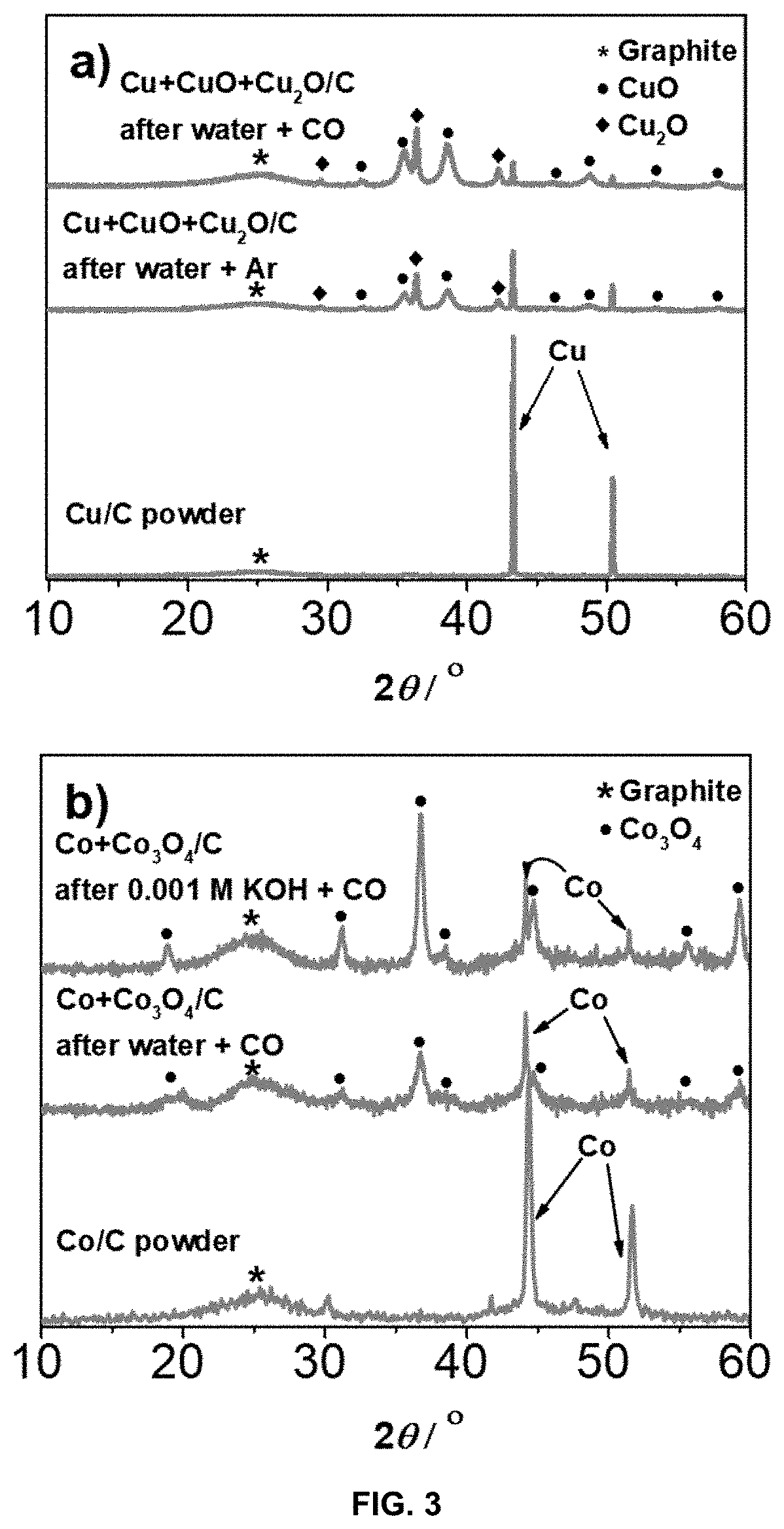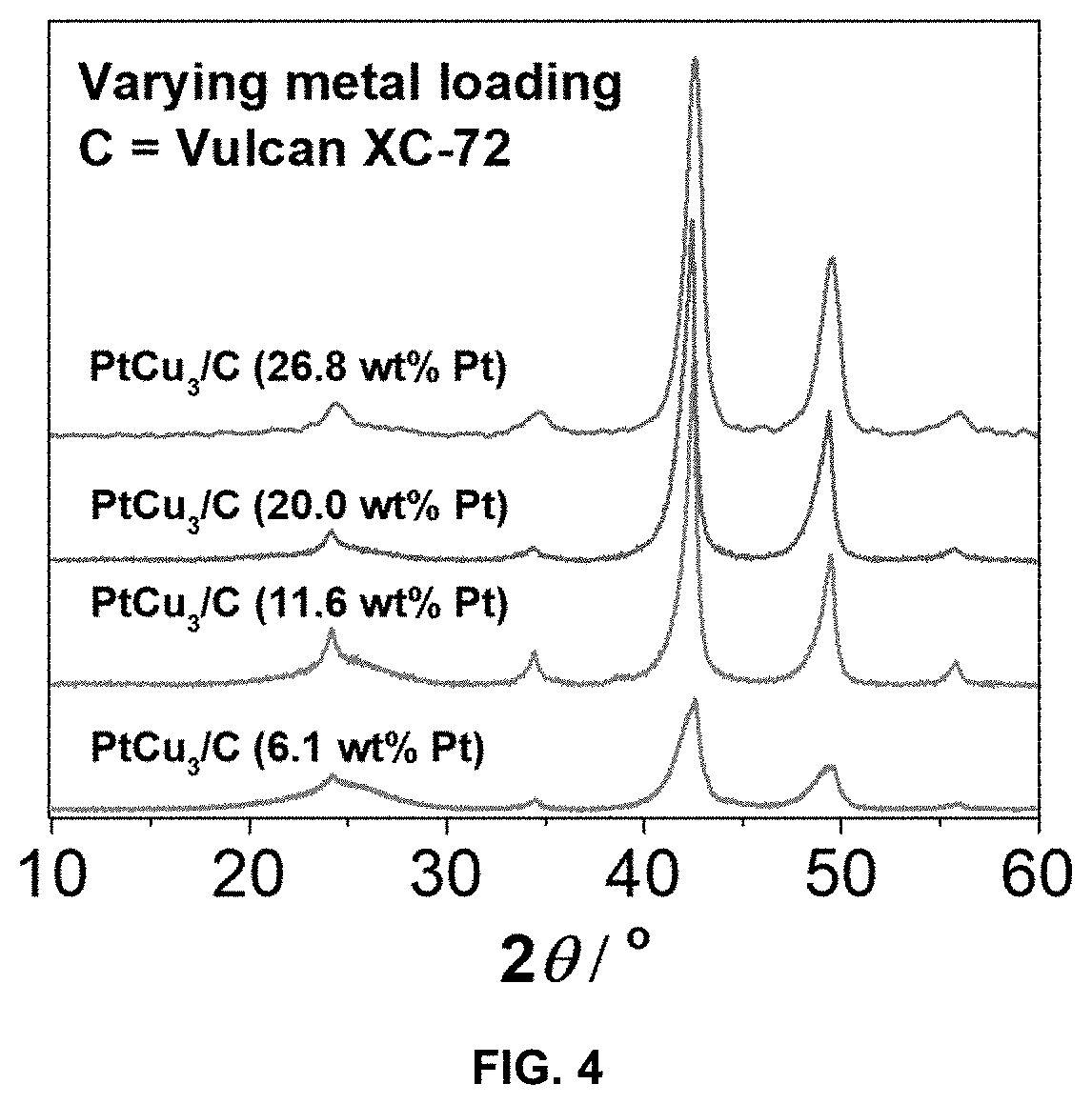Method for preparation of a supported noble metal-metal alloy composite, and the obtained supported noble metal-metal alloy composite
- Summary
- Abstract
- Description
- Claims
- Application Information
AI Technical Summary
Benefits of technology
Problems solved by technology
Method used
Image
Examples
examples
[0103]The present invention is exemplified in following Examples 1-17 by the Pt-M alloy system, wherein M is Cu, Ni or Co, and noble metal is Pt. In the said Examples commercial carbon supports of Vulcan XC72, Ketjen Black EC300J, Printex® XE2 and Ketjen Black EC600J were used, which are all carbon black materials, with BET surface area between 250 and 1400 m2 / g. The Examples also includes support materials reduced graphene oxide and TiOxNy. The following examples should not be understood as limiting for the present invention as the noble metal Pt may be alloyed with other less noble metals, M, and the support material can be any other support material as defined above.
[0104]In the present Pt-M alloy embodiment, the strong interaction between CO (carbon monoxide) gas and Pt is used as a capping agent restricting Pt nanoparticles to grow during the GD reaction. This approach not only results in synthesis of very small and well dispersed nanoparticles, but is also very energy efficien...
example 1
[0127]1-6 grams of Cu / C (C carbon black with a BET surface area of 250 m2 / g) with 25.5 wt % Cu was suspended in 100 mL (200 mL for 6 grams batch) of ultrapure water in a two neck round-bottom flask. The suspension was placed on an ultrasound bath (Ultrasound bath Iskra Sonis 4) for 3 minutes for degassing. Afterwards, the suspension was purged with Ar for 45 minutes. The suspension was then bubbled with CO gas for 15 minutes while stirring with a magnetic stirrer at 900 rpm to achieve saturation. After 15 minutes of bubbling with CO (g), 11 mL of 0.1 M K2PtCl4 (Apollo scientific) per gram of Cu / C was added with a syringe pump (WPI sp100i, flow 160 mL / h) continuously while purging the reaction mixture with CO (g). After entire Pt precursor was added to the reaction mixture, the suspension was filtered and redispersed in fresh ultrapure water. After 15 minutes of mixing, the suspension was once again filtered and the process was repeated in total 3 times. After the last filtration, th...
example 2
[0128]2 grams of Cu / C (C: carbon black with a BET surface area of 250 m2 / g) with 9.3 wt % Cu was suspended in 250 mL of ultrapure water in a two neck round-bottom flask. The suspension was placed on an ultrasound bath (Ultrasound bath Iskra Sonis 4) for 3 minutes (degassing). Afterwards, the suspension was purged with CO for 15 minutes while stirring with a magnetic stirrer at 900 rpm to achieve saturation. After 15 minutes of bubbling with CO, 3.3 mL of 0.1 M K2PtCl4 (Apollo scientific) per gram of Cu / C was added with a syringe pump (WPI sp100i, flow 160 mL / h) continuously while purging the reaction mixture with CO. The rest of the synthesis was the same as in the case of Example 1. PtCu3 / C electrocatalyst with 6.1 wt % Pt and 8.6 wt % Cu was collected at the end.
PUM
| Property | Measurement | Unit |
|---|---|---|
| Electrical conductivity | aaaaa | aaaaa |
| Solubility (mass) | aaaaa | aaaaa |
| Electrical conductor | aaaaa | aaaaa |
Abstract
Description
Claims
Application Information
 Login to View More
Login to View More - R&D
- Intellectual Property
- Life Sciences
- Materials
- Tech Scout
- Unparalleled Data Quality
- Higher Quality Content
- 60% Fewer Hallucinations
Browse by: Latest US Patents, China's latest patents, Technical Efficacy Thesaurus, Application Domain, Technology Topic, Popular Technical Reports.
© 2025 PatSnap. All rights reserved.Legal|Privacy policy|Modern Slavery Act Transparency Statement|Sitemap|About US| Contact US: help@patsnap.com



